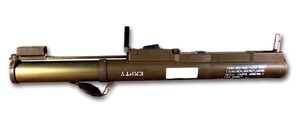M72 LAW
| M72 LAW | |
|---|---|
 The M72 LAW in extended position |
|
| Type | Anti-tank |
| Place of origin | |
| Production history | |
| Designer | FA Spinale, CB Weeks and PV Choate |
| Designed | Patent filed 1963 |
| Manufacturer | Talley Industries and under license by Raufoss Ammunisjonsfabrikker A/S, |
| Unit cost | 670 € or $1,045US (Converted) |
| Specifications | |
| Weight | 2.5 kg |
| Length | less than 1 m |
|
|
|
| Caliber | 66 mm |
| Muzzle velocity | 145 m/s |
| Effective range | 200m |
| Detonation mechanism |
point-initiated, base-detonated |
| 1960s Weapons Similar to M72 | |
|---|---|
| SARPAC top, M72 LAW middle, MINIMAN bottom | |
The M72 LAW (Light Anti-Tank Weapon, also referred to as the Light Anti-Armor Weapon or LAW as well as LAWS Light Anti-Armor Weapons System) is a portable one-shot 66 mm unguided anti-tank weapon, designed in the United States by Paul V. Choate, Charles B. Weeks, and Frank A. Spinale et al. while with the Hesse-Eastern Division of Norris Thermadore, currently produced by Nammo Raufoss AS in Norway.
In early 1963 the LAW was adopted by the United States Army and the United States Marines as their primary individual infantry anti-tank weapon, replacing the M31 HEAT rifle grenade and the M20A1 "Super Bazooka" in the US Army.[1][2]
It had been intended that in the early 1980s that the M72 would be replaced by the FGR-17 Viper, but this program was canceled by Congress and the M136 AT4 was introduced in its place. In that time period its nearest comparison was the Swedish Pskott m/68 (Miniman) and the French SARPAC.[3]
Contents |
History
During World War II, the sudden prominence of tanks and other armored vehicles on the battlefield led to the creation of man-portable weapons that would enable the humble infantryman to successfully deal with the new threat. The first such weapons to be used with limited success were flamethrowers, satchel charges, jury-rigged landmines and specially designed magnetic hollow charges, but all these weapons needed to get within a couple of meters from the target to be effective, which severely limited said effectiveness and greatly endangered the user.
The U.S. Army then introduced the bazooka on the battlefield, the first true rocket-propelled grenade launcher, which proved devastatingly effective against enemy armor. It was such a success that all involved nations soon bought or copied the bazooka for extensive use on all fronts.
But the bazooka had its drawbacks: large, cumbersome and rather fragile; it needed a dedicated (and trained) two-man team to be used efficiently. Hard-pressed on all fronts, Germany then developed an alternative to the bazooka: the Panzerfaust family of weapons. These one-shot rocket launchers were relatively cheap, needed no particular training (they were so simple of use that they were regularly issued to Volkssturm regiments) and proved remarkably efficient against Russian armor on the eastern front.
The M72 LAW is the descendant of the Panzerfaust: a sturdy, lightweight, easy-of-use one-shot anti-tank rocket launcher.
Description

The weapon consists of a rocket packed inside of a launcher made up of two tubes, one inside the other. While closed, the outer assembly acts as a watertight for the rocket and the percussion cap-type firing mechanism that activates the rocket. The outer tube contains the trigger, the arming handle, front and rear sights, and the rear cover. The inner tube contains the channel assembly which houses the firing pin assembly, including the detent lever. When extended, the inner tube telescopes outward toward the rear, guided by the channel assembly which rides in an alignment slot in the outer tube's trigger housing assembly. This causes the detent lever to move under the trigger assembly in the outer tube, both locking the inner tube in the extended position and cocking the weapon. Once armed, the weapon is no longer watertight even if the launcher is collapsed into its original configuration.
When fired, the striker in the rear tube impacts a primer which ignites a small amount of powder that "flashes" down a tube to the rear of the rocket igniting the propellant in the rocket motor, The rocket motor burns complete before leaving the mouth of the launcher, producing gases around 1,400 °F (760 °C). The rocket propels the 66 mm warhead forward without significant recoil. As the warhead emerges from the launcher, six fins spring out from the base of the rocket tube, stabilizing the warhead's flight.[4] The early LAW warhead, developed from the M31 HEAT rifle grenade warhead, uses a simple, but extremely safe and reliable piezoelectric fuze system, which on impact with the target a certain type of crystal in the front nose section is crushed causing a mico-second electric current to be generated which detonates the warhead. The fuse then detonates a booster charge located in the base of the warhead which sets off the main warhead charge. The force of the main charge forces the copper liner into a directional particle jet that in relation to the size of the warhead is capable of massive amount of penetration. A unique mechanical set-back safety on the base of the detonator grounds the circuit till the missile is accelerated from the tube. The accelerations causes each of the 3 disk in the set back to rotate 90 degrees in succession, ungrounding the circuit and completing a circuit from the nose to the base of the detonator when the piezo-electric crystal is crushed on impact.
Ammunition

The M72A2 LAW was issued as a prepackaged round of ammunition. Improvements to the launcher and differences in the ammunition were differentiated by a single designation. The most common M72A2 LAWs came prepacked with a rocket containing a 66 mm HEAT warhead which is attached to the inside of the launcher by the igniter. The standard M72A2 antiarmor HEAT warhead has an official stated penetrate in 1977 of up to 20 cm/8 inches of steel plate, 600mm (2 feet) of reinforced concrete, or 1.8 meters (6 feet) of soil.[5][6]
A training variant of the M72 LAW, designated the M190, also exists. This weapon is reloadable and uses the 35 mm M73 training rocket. A subcaliber training device that uses a special tracer cartridge also exists for the M72. A training variant used by the Finnish armed forces fire 7.62mm tracer rounds.
The US Army tested other 66 mm rockets based on the M54 rocket motor used for the M72. The M74 TPA (Thickened Pyrophoric Agent) had an Incendiary warhead filled with TEA (triethylaluminium); this was used in the M202A1 FLASH (FLame Assault SHoulder weapon) 4-tube launcher. The XM96 RCR (Riot Control Rocket) had a CS gas-filled warhead for crowd control and was used with the XM191 quadruple-tube launcher.
Once fired in combat the launcher is required to be destroyed by the U.S. Military to prevent its use by the enemy. Due to the single use nature of the weapon, it was issued as what is called a "wooden-round" of ammunition by the Canadian Army and the United States Army, requiring no checks or maintenance, just as small arms ammunition can be stored in the same manner for years with out any problems.
Service history

Although generally thought of as a Vietnam War era weapon which has been superseded by more powerful AT4, the M72 LAW has found a new lease of life in the ongoing (2006) operations in Iraq by the US Army and Afghanistan by the Canadian Army. The lower cost and lighter weight of the LAW, combined with a lack of modern heavy armored targets and the need for an individual assault vs an individual antiarmor weapon, make it ideal for the type of urban combat seen in Iraq and mountain warfare seen Afghanistan today. In addition a soldier can only carry one AT4 a mission, but with the LAW he can carry two.[7]
During the Vietnam and post-Vietnam periods, all issued LAWs were recalled due to instances of the warhead exploding in flight, sometimes injuring the operator. After safety improvements, part of the training and firing drills included the requirement to ensure the words "w/coupler" were included in the text description stenciled on the launcher, which indicated the launcher had the required safety modification(s).[8]
With the failure of the M72 replacement the Viper, Congress in late 1982 ordered the US Army to test off-the-shelf light antitank weapons and report back by the end of 1983. In partnership with Raufoss AS, Talley Defense offered the M72E5, which offered increased range, penetration and better sights, which was tested along with five other light anti-armour weapons in 1983. For all the improvements the M72E5 offered the AT4 was chosen to replace the M72.[9][10]
The M72 LAW is also extensively used in the Finnish Army (some 70,000 pieces), where it is known under the designations 66 KES 75 (M72A2, no longer in service) and 66 KES 88 (M72A5). In accordance with the weapon's known limitations, a pair of "tank buster" troops crawl to a firing position some 50 to 150 yards away from the target, bringing with them four to six LAWs which are then used in rapid succession until the target is destroyed or incapacitated.
The British Army used the Norwegian-built version of the M72 under the designation "Rocket 66mm HEAT L1A1" which was replaced by LAW 80.[11][12]
The Turkish Army uses a Turkish-built version by Makina ve Kimya Endustrisi Kurumu, called HAR-66, which has the performance and characteristics of a mix of M72A2 and A3. Turkey also indigenously developed an anti-personnel warhead version of HAR-66 and called it "Eşek Arısı"(HORNET)
The Australian Army uses the M72A6 as an anti-building and secondary anti-armour weapon. It is carried by regular riflemen (including on operations in Iraq), while the heavier 84 mm Carl Gustaf and Javelin are generally equipped by dedicated anti-armour troops.
The Republic of China Army (Taiwan) uses the M72 as a secondary anti-armor weapon. It is used primarily as a backup to the Javelin and the M136 (AT4) anti-tank weapons.

The Light Anti-Structures Missile (LASM) is the name of the L72A9 in UK service.[13] The main difference is the warhead: the LASM contains about 1 kg of an enhanced blast explosive, whereas the LAW contains about a third of a kilogram.[14][15] The United States armed forces may refer to the LASM as a M72A9 LAW (Light Assault Weapon). The M72A10 has the FFE (Fire From Enclosure) capability. Recently the US Marine Corps Systems Command at Quantico, Virginia placed a 15.5 million dollar fixed contract order with Talley Defense for 7,750 M72A7s, with delivery to be completed April 2011 [16][17]
Demonstration
- A fairly accessible demonstration of the use of this rocket (including a good reason for not standing behind one when it goes off) is featured in the Clint Eastwood film The Enforcer.[18]
Surplus demand and replicas
- Expended LAW tubes may be found on the US military surplus and gun show market, and purchased by militaria collectors.
The LAW has been replicated for airsoft games, with metal and plastic launchers available. All fire 40mm shower grenades, and most official ones are made by Deepfire.
Other variants
US variants
| Designation | Description |
|---|---|
| M72 | 66 mm Talley single shot disposable rocket launcher; pre-loaded w/ HEAT rocket |
| M72A1 | M72 variant; improved rocket motor |
| M72A2 | M72 variant; improved rocket motor |
| M72A3 | M72A1/A2 variant; safety upgrades |
| M72A4 | M72 variant; rocket optimised for high-penetration; uses improved launcher assembly |
| M72A5 | M72A3; uses improved launcher assembly |
| M72A6 | M72 variant; rocket w/ low penetration, improved blast effect; uses improved launcher assembly |
| M72A7 | M72A6 variant; US Army M72A6 variant for US Navy |
| M72E8 | M72A7 variant; Fire-From-Enclosure (FFE) capable rocket motor; uses improved launcher assembly |
| M72E9 | M72 variant; rocket w/ improved anti-armour capability; uses improved launcher assembly |
| M72E10 | M72 variant; HE-Frag rocket; uses improved launcher assembly |
| M72 Enhancements Early 1980s | |
|---|---|
| M72E4, M72E5, M72E6 - Talley brochure | |
| Pop-up "Rifle Sights" adopted from canceled Viper - Talley brochure | |
International variants and designations
| Designation | Nation | Description |
|---|---|---|
| 66 KES 75 | Finland | Designation for the M72A2 |
| 66 KES 88 | Finland | Designation for the M72A5 |
| HAR-66 | Turkey | Turkish variant incorporating M72A2 rocket improvements and M72A3 safety improvements |
| Rocket 66mm HEAT L1A1 | United Kingdom | Designation for the M72 |
| Light Anti-Structures Missile (LASM) | United Kingdom | Designation for the M72A9 |
Specifications (M72A2 and M72A3)

Launcher
- Length:
- Extended: less than 1 m (35 in).
- Closed: 0.67 m (24.8 in).
- Weight:
- Complete M72A2: 2.3 kg (5.1 lb).
- Complete M72A3: 2.5 kg (5.5 lb).
- Firing mechanism: Percussion.
- Front sight: reticle graduated in 25 m range increments.
- Rear sight: peep sight adjusts automatically to temperature change.
Rocket
- Caliber: 66 mm (2.6 in)
- Length': 508 mm (20 in)
- Weight: 1.8 kg (4 lb)
- Muzzle velocity: 145 m/s (475 ft/s)
- Minimum range (combat): 10 m (33 ft)
- Minimum arming range: 10 m (33 ft)
- Maximum range: 1,000 m (3,300 ft)
- Penetration: 200 mm (8 inches)[5]
Maximum effective ranges
- Stationary target: 200 m (220 yd)
- Moving target:165 m (180 yd)
- Beyond these ranges there is less than a 50 % chance of hitting the target.
Users
 Australia: M72A6 variant.[19]
Australia: M72A6 variant.[19] Austria[19]
Austria[19].svg.png) Belgium[19]
Belgium[19] Canada[19]
Canada[19] Chile: M72A3 variant.[19]
Chile: M72A3 variant.[19] El Salvador[20]
El Salvador[20] Finland[19]
Finland[19] Luxembourg[19]
Luxembourg[19] Morocco[19]
Morocco[19] Netherlands[19]
Netherlands[19] New Zealand[19]
New Zealand[19] Norway[19]
Norway[19] Portugal[21]
Portugal[21] South Korea[19]
South Korea[19] Spain: M72A3 variant.[19]
Spain: M72A3 variant.[19] Taiwan[19]
Taiwan[19] Thailand[19]
Thailand[19] Turkey[19]
Turkey[19] United Kingdom: Used by the British Army from the 1970s to the early 1990s.[22]
United Kingdom: Used by the British Army from the 1970s to the early 1990s.[22] United States[19]
United States[19] Yemen[19]
Yemen[19]
See also
- Rocket-propelled grenade
- Shoulder-Launched Multipurpose Assault Weapon
- List of U.S. Army Rocket Launchers By Model Number
Similar weapons
- AT4
- RPG-18 / RPG-22
- RPG-76
- M80 "Zolja"
References
- ↑ Mary T. Cagle "History of the TOW Missile System" page 10, US Army 1977 Redstone Arsenal Pdf file of official TOW history that discussed the new family of antitank weapons, the M72 LAW, the Dragon and the TOW
- ↑ The US Army partially replaced the Super Bazooka not only with the M72 LAW, but also M67 recoilless rifle and US Marines kept the Super Bazooka in service till the late 1960s
- ↑ SARPAC was never adopted by the French Army - export only
- ↑ no matter what you see in the movies, there is no "Whoosh!" on launch -- ie more of a loud "BANG!!" or a "BLOOP!" for the training versions -- and there is no smoke trail behind the rocket as it heads towards the target
- ↑ 5.0 5.1 US Army publication September 30, 1977 "FM-7 The Mechanized Infantry Platoon/Squad Section B-21"
- ↑ Note - before the publication of FM-7 September 1977, various penetration specifications were given for the M72A2 and the M31 HEAT. Anywhere from 250mm to 305mm. In the mid 1970s the US Army decided in test to truly determine the armour penetration under battlefield conditions again Russian tanks captured in 1973. The results was 20cm/8 inches the proceeding penetration specification is stated as it appears in FM-7 1977.
- ↑ Marines Fought the LAW, and the LAW Won
- ↑ some reports state it was over water in the flash tube causing dangerous misfires and unproven rumors of possible sabotage at the manufacturing plant during the Vietnam War
- ↑ D. Kyle, Armed Forces Journal International/November 1983 "Viper Dead, Army Picks AT-4 Antitank Missile" page 21
- ↑ Various reports in 1983 stated that during the Congressional mandated tests the first M72E5 tested had an accuracy problem, because of its' larger diameter rocket motor, interfered with the deployment of all the stabilizing fins after leaving the launcher. The manufactures have since made modifications that have worked that problem out.
- ↑ "Jane's Infantry Weapons 1995-1996" page 686
- ↑ various news reports show British soldiers in Afghanistan with M72 LAWs - probably purchased after 9/11
- ↑ "LASM". http://www.army.mod.uk/equipment/support-weapons/1465.aspx. "The Light Anti-Structures Missile (LASM) is an Urgent Operational Requirement order which has been fielded to fill a capability gap until ASM comes into service."
- ↑ Oh, the Horror, the Horror at the Wayback Machine (archived March 26, 2008).
- ↑ "M72 Light Anti-tank (sic) Weapon System (LAW)". Gary's U.S. Infantry Weapons Reference Guide. http://www.inetres.com/gp/military/infantry/antiarmor/M72.html.
- ↑ John Antal "Packing a Punch: America's Man-Portable Antitank Weapons" page 88 Military Technology 3/2010 ISSN 0722-3226
- ↑ "Light Assault Weapon (LAW)". FBO.gov. https://www.fbo.gov/index?tab=core&s=opportunity&mode=form&id=6aea0552c87c7c9afb20167e1b193acc.
- ↑ note - . The film is not accurate in that it shows the missile visible in flight trailing an exhaust plume. In reality, the flight of the missile is extremely fast and it coasts to the target, the launch motor being completely expended while the missile is inside the launcher.
- ↑ 19.00 19.01 19.02 19.03 19.04 19.05 19.06 19.07 19.08 19.09 19.10 19.11 19.12 19.13 19.14 19.15 19.16 19.17 Jones, Richard D. Jane's Infantry Weapons 2009/2010. Jane's Information Group; 35 edition (January 27, 2009). ISBN 978-0-7106-2869-5.
- ↑ "El Salvador". Military Technology World Defence Almanac (Bonn : Wehr & Wissen): 60. 2005. ISSN 0722-3226.
- ↑ Portuguese soldier firing M72
- ↑ Owen, William F. (2007). "Light Anti-Armour Weapons: Anti-Everything?". http://asianmilitaryreview.com - Asian Military Review. http://www.asianmilitaryreview.com/upload/200712031855161.pdf. Retrieved 2010-05-12.
External links
- FAS
- Gary's U.S. Infantry Weapons Reference Guide
- Article on the reintroduction of the LAW in Iraq by the USMC
- Canadian Military Page On the M72
- Patent for sights of M 72 Patented by Paul V. Choate of Milton, MA.
- Patented by Paul V. Choate of Milton, MA.
- 1960s US Army M72 Training film
|
|||||||||||||||||||||||||||||||||||||||||||
|
|||||||||||||||||||||||||||||||||||
|
|||||||||||||||||||||||||||||||||||||||||||||||||||||||||||||||
|
||||||||||||||||||||||||||
